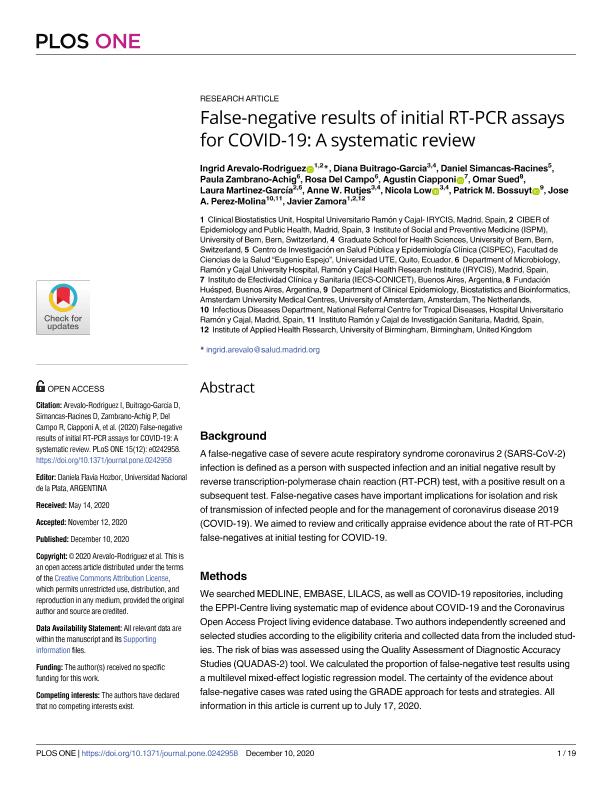Mostrar el registro sencillo del ítem
dc.contributor.author
Arevalo Rodriguez, Ingrid
dc.contributor.author
Buitrago Garcia, Diana
dc.contributor.author
Simancas Racines, Daniel
dc.contributor.author
Zambrano Achig, Paula
dc.contributor.author
Del Campo, Rosa
dc.contributor.author
Ciapponi, Agustín

dc.contributor.author
Sued, Omar Gustavo

dc.contributor.author
Martinez García, Laura
dc.contributor.author
Rutjes, Anne W.
dc.contributor.author
Low, Nicola
dc.contributor.author
Bossuyt, Patrick M.
dc.contributor.author
Perez Molina, Jose A.
dc.contributor.author
Zamora, Javier
dc.date.available
2021-06-15T03:14:49Z
dc.date.issued
2020-12-10
dc.identifier.citation
Arevalo Rodriguez, Ingrid; Buitrago Garcia, Diana; Simancas Racines, Daniel; Zambrano Achig, Paula; Del Campo, Rosa; et al.; False-negative results of initial RT-PCR assays for COVID-19: A systematic review; Public Library of Science; Plos One; 15; 12; 10-12-2020; 1-19
dc.identifier.issn
1932-6203
dc.identifier.uri
http://hdl.handle.net/11336/133841
dc.description.abstract
Background A false-negative case of severe acute respiratory syndrome coronavirus 2 (SARS-CoV-2) infection is defined as a person with suspected infection and an initial negative result by reverse transcription-polymerase chain reaction (RT-PCR) test, with a positive result on a subsequent test. False-negative cases have important implications for isolation and risk of transmission of infected people and for the management of coronavirus disease 2019 (COVID-19). We aimed to review and critically appraise evidence about the rate of RT-PCR false-negatives at initial testing for COVID-19. Methods We searched MEDLINE, EMBASE, LILACS, as well as COVID-19 repositories, including the EPPI-Centre living systematic map of evidence about COVID-19 and the Coronavirus Open Access Project living evidence database. Two authors independently screened and selected studies according to the eligibility criteria and collected data from the included studies. The risk of bias was assessed using the Quality Assessment of Diagnostic Accuracy Studies (QUADAS-2) tool. We calculated the proportion of false-negative test results using a multilevel mixed-effect logistic regression model. The certainty of the evidence about false-negative cases was rated using the GRADE approach for tests and strategies. All information in this article is current up to July 17, 2020. Results We included 34 studies enrolling 12,057 COVID-19 confirmed cases. All studies were affected by several risks of bias and applicability concerns. The pooled estimate of false-negative proportion was highly affected by unexplained heterogeneity (tau-squared = 1.39; 90% prediction interval from 0.02 to 0.54). The certainty of the evidence was judged as very low due to the risk of bias, indirectness, and inconsistency issues. Conclusions There is substantial and largely unexplained heterogeneity in the proportion of false-negative RT-PCR results. The collected evidence has several limitations, including risk of bias issues, high heterogeneity, and concerns about its applicability. Nonetheless, our findings reinforce the need for repeated testing in patients with suspicion of SARS-Cov-2 infection given that up to 54% of COVID-19 patients may have an initial false-negative RT-PCR (very low certainty of evidence).
dc.format
application/pdf
dc.language.iso
eng
dc.publisher
Public Library of Science

dc.rights
info:eu-repo/semantics/openAccess
dc.rights.uri
https://creativecommons.org/licenses/by-nc-sa/2.5/ar/
dc.subject
RT-PCR
dc.subject
False-negative
dc.subject
Systematic review
dc.subject
COVID-19
dc.subject.classification
Otras Ciencias de la Salud

dc.subject.classification
Ciencias de la Salud

dc.subject.classification
CIENCIAS MÉDICAS Y DE LA SALUD

dc.title
False-negative results of initial RT-PCR assays for COVID-19: A systematic review
dc.type
info:eu-repo/semantics/article
dc.type
info:ar-repo/semantics/artículo
dc.type
info:eu-repo/semantics/publishedVersion
dc.date.updated
2021-06-14T15:10:30Z
dc.journal.volume
15
dc.journal.number
12
dc.journal.pagination
1-19
dc.journal.pais
Estados Unidos

dc.journal.ciudad
San Francisco
dc.description.fil
Fil: Arevalo Rodriguez, Ingrid. Ciber of Epidemiology And Public Health; España. Hospital Universitario Ramón y Cajal; España
dc.description.fil
Fil: Buitrago Garcia, Diana. University of Bern; Suiza
dc.description.fil
Fil: Simancas Racines, Daniel. Universidad Ute; Ecuador
dc.description.fil
Fil: Zambrano Achig, Paula. Hospital Universitario Ramón y Cajal; España
dc.description.fil
Fil: Del Campo, Rosa. Hospital Universitario Ramón y Cajal; España
dc.description.fil
Fil: Ciapponi, Agustín. Instituto de Efectividad Clínica y Sanitaria; Argentina. Consejo Nacional de Investigaciones Científicas y Técnicas; Argentina
dc.description.fil
Fil: Sued, Omar Gustavo. Fundación Huésped; Argentina
dc.description.fil
Fil: Martinez García, Laura. Ciber of Epidemiology And Public Health; España. Hospital Universitario Ramón y Cajal; España
dc.description.fil
Fil: Rutjes, Anne W.. University of Bern; Suiza
dc.description.fil
Fil: Low, Nicola. University of Bern; Suiza
dc.description.fil
Fil: Bossuyt, Patrick M.. University of Amsterdam; Países Bajos
dc.description.fil
Fil: Perez Molina, Jose A.. Hospital Universitario Ramón y Cajal; España
dc.description.fil
Fil: Zamora, Javier. Hospital Universitario Ramón y Cajal; España. Ciber of Epidemiology And Public Health; España. University of Birmingham; Reino Unido
dc.journal.title
Plos One

dc.relation.alternativeid
info:eu-repo/semantics/altIdentifier/doi/http://dx.doi.org/10.1371/journal.pone.0242958
dc.relation.alternativeid
info:eu-repo/semantics/altIdentifier/url/https://journals.plos.org/plosone/article?id=10.1371/journal.pone.0242958
Archivos asociados
